 |
| IT WENT STRAIGHT DOWN FROM 30,000 FT. LIKE MH370 |
Rescuers have not yet been able to find any dead or survivors of the China Eastern Airlines Boeing 737 crash. The plane crashed yesterday in the mountains of Teng County, Wuzhou City in southern China.
“To date, according to rescuers, the wreckage of the crashed aircraft has been found at the scene, but no missing persons have yet been found”, - China Central Television said in a report dated 4:50 Moscow time.
The search is currently ongoing. They are complicated by the difficulties associated with the landscape - the mountainous terrain greatly complicates the work of rescuers.
It's worth reminding that the plane was flying from Kunming to Guangzhou. A fire broke out at the crash site. Rescuers went to the crash site.
'Catastrophic incident on board' Chinese plane sparked death plunge, expert says
22 March 2022, 10:51

The plane crash in China that claimed 132 lives could have been caused by a "catastrophic incident" on board the flight, an expert analyst has told LBC.
Nobody survived the devastating crash in which the passenger plane plunged thousands of feet from the sky in an almost vertical freefall.
Speaking to LBC, expert Sally Gethin explained how the Boeing 737 suddenly dropped from the sky after an apparent attempt to 'level off' its flightpath, and detailed what could have be the reason behind the disaster.
"It's really hard to ascertain at this point in time whether the aircraft was entirely intact when it dropped so suddenly," she said.
"I would tend to think that there had already been a catastrophic incident on board for it to be able to drop so dramatically in that way.
"But at the same time, it could also be a problem that the pilot was struggling with and finally lost control."
Despite speculation, Ms Gethin said the real reason behind the crash would hopefully be uncovered when the two black boxes - the data recorder and the voice recorder - are uncovered from the wreckage.
"[It] will be revealed in their communications with the radar control, with their traffic management side, and that will be revealed in the voice recorder," she said.
Read more:
Read more:
When asked about unverified footage showing a plane nosediving, she explained: "[The plane] was at nearly 30,000 feet - which is cruising altitude - and from the ground that would look like a dot up in the sky.
"It fell from that height – nearly 30,000 feet – suddenly perpendicular.
"It maintained some stability, it paused and then several seconds later it then dropped again suddenly.
"That footage captures it in that second phase, where it drops completely vertically to the ground."
She went on to say: "The impact of the crash ruled out survivors because there was no chance to land it in a gradual way."
Chinese media carried brief highway video images from a vehicle's dashboard camera that appeared to show a jet diving to the ground at an angle of about 35 degrees from the vertical.

Paramilitary police officers work at the site where a China Eastern Airlines Boeing 737-800 plane flying from Kunming to Guangzhou crashed, in Wuzhou, Guangxi Zhuang Autonomous Region, China March 21, 2022.
Wuzhou: Rescuers scoured heavily forested mountain slopes in southern China on Tuesday looking for victims and flight recorders from a China Eastern Airlines passenger jet that crashed a day earlier with 132 people on board.
“Parts of the Boeing 737-800 were strewn among trees charred by fire after China’s first crash of a commercial jetliner since 2010. Burnt remains of identity cards and wallets were also seen,” state media said.
Flight MU5735 was travelling to the port city of Guangzhou from Kunming, capital of the southwestern province of Yunnan, when it suddenly plunged from cruising altitude and crashed in the mountains of Guangxi less than an hour before it was due to land.
Chinese media carried brief highway video images from a vehicle’s dashboard camera that appeared to show a jet diving to the ground at an angle of about 35 degrees from the vertical. Reuters could not immediately verify the footage.
Si, 64, a villager near the crash site who declined to give his first name, told Reuters he heard a “bang, bang” at the time of the crash.
“It was like thunder,” he said.

Plane debris is seen at the site where a China Eastern Airlines Boeing 737-800 plane flying from Kunming to Guangzhou crashed, in Wuzhou, Guangxi Zhuang Autonomous Region, China March 21, 2022.
State media, which described the situation as “grim”, have said the possibility of the deaths of all on board could not be ruled out.
The crash site was hemmed in by mountains on three sides, state media said, with just one tiny path providing access. Rain was forecast in the area this week. Excavators were clearing a path to the site on Tuesday, images on state television showed.
Earlier, video images from the People’s Daily, the official newspaper of the ruling Communist Party, showed search and rescue workers and paramilitary forces scaling tree-covered hillocks and placing markers wherever debris was found.
Police set up a checkpoint at Lu village, on the approach to the site, and barred journalists from entering.
Several people gathered near the crash site on Tuesday for a small Buddhist ceremony.
Abrupt Descent
An investigation team sent by the State Council, or cabinet, will give details of the search and rescue effort and the hunt for the black boxes at a news conference on Tuesday evening, state television said.
The last commercial jetliner to crash in China was in 2010, when an Embraer E-190 regional jet flown by Henan Airlines went down, killing 44 of the 96 aboard.

Militia members speak with a manager at the entrance of Lu village near the site where the China Eastern Airlines Boeing 737-800 plane crashed, March 22, 2022. Photo: Reuters/Carlos Garcia Rawlins
Highlighting the top-level concern, Vice Premier Liu He went to Guangxi on Monday night to oversee search and rescue operations.
The disaster comes as planemaker Boeing seeks to rebound from several crises, notably the impact of the coronavirus pandemic on air travel and safety concerns over its 737 MAX model following two deadly crashes.
Once it is found, the cockpit voice recorder could yield clues to what went wrong with Monday’s flight.
“Accidents that start at cruise altitude are usually caused by weather, deliberate sabotage, or pilot error,” Dan Elwell, a former head of US regulator the Federal Aviation Administration, told Reuters.
Elwell, who led the FAA during the 737-MAX crisis, said mechanical failures in modern commercial jets were rare at cruise altitude.
The US National Transportation Safety Board (NTSB) on Monday appointed an investigator, as the Boeing aircraft was produced in the United States, but it was unclear if the investigator would travel to China.
On Monday, China Eastern and two subsidiaries grounded its fleet of 737-800 planes. The group has 225 of the aircraft, data from British aviation consultancy IBA shows.
As of Tuesday, other Chinese airlines had yet to cancel any flights that use 737-800 aircraft, according to data from Chinese aviation data provider Flight Master.
Among the passengers on flight MU5735 was the chief financial officer of Dinglong Culture, a Guangzhou-headquartered firm whose businesses range from entertainment to titanium mining.
A provincial daily cited a woman as saying six of her family members and friends were on the flight to Guangzhou, where they had been due to attend a funeral.
Onshore-listed shares of China Eastern slumped over 6.5% on Tuesday, while those trading in Hong Kong fell nearly 6%.
By Eryk Bagshaw
Updated March 22, 2022
Singapore: A leading air crash investigator says foul play should be at the top of the list for authorities investigating the crash of China Eastern Airlines flight MU5735, after the flight’s almost vertical descent matched the fate of two previous disasters.
Michael Daniel, who worked on investigations into Egypt Air flight 990 and SilkAir flight 185, which were both deliberately crashed by the pilot - according to the US National Transportation Safety Board - also had “very quick, very sudden and straight” dives straight into the ground.
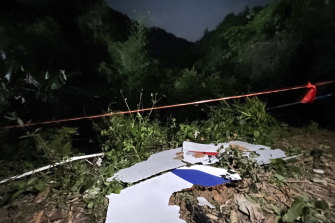
Debris seen at the crash site in Guangxi. CREDIT:AP
“I think that’d be one of the first things I would look at is foul play,” said Daniel.
The US Federal Aviation Administration investigator said the plane had power as it was descending. “So, that kind of rules out a catastrophic type of failure,” he said.
“Even with catastrophic failures, a lot of times you’ll see some opportunity for declaring an emergency, or mayday or, or something along those lines. There’s nothing that’s been released here that indicates any kind of distress call. ”
Daniel, the senior policy manager at consultancy firm Aviation Insight, said if the horizontal stabiliser, which controls the vertical balance of the aircraft, was stuck, you would still likely see some wavering on the plane.
But MU5735 fell almost 8000 metres in two minutes, FlightRadar 24 data shows, plunging at such a speed that parts of the plane fell off as it hurtled towards the mountains that surround Wuzhou in southeastern China. Video on social media sites from a mining CCTV camera and a car dashcam appeared to show the plane plunging nose-first from the sky into the ground before sending up a plume of smoke that could be seen up to five kilometres away.
There were 132 people on board. Chinese authorities have not reported any survivors almost 24 hours after the flight took off from Kunming to Guangzhou. Emergency workers have recovered burnt ID documents and wallets from the site.
Advertisement
Families of the passengers and crew have descended on Kunming and Guangzhou airports hoping for good news but so far have only received statements from the Civil Aviation Administration of China that a rescue effort was ongoing.
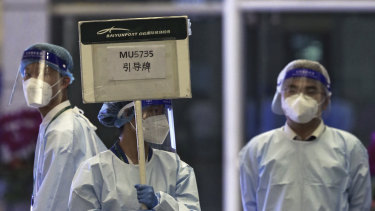
A worker from the China Eastern holds a signboard waiting to lead relatives of the victims aboard China Eastern’s flight MU5735 to a cordoned off area, in Guangzhou Baiyun International Airport in Guangzhou.
Other air crash investigators and aviation safety analysts have been puzzled by the flights’ trajectory while warning it was too early to say what the cause of the accident was. The Boeing 737-800 has a good safety record.
“It’s an odd profile,” John Cox, an aviation safety consultant and former 737 pilot told Bloomberg. “It’s hard to get the airplane to do this.”
The former director of the French Bureau of Enquiry and Analysis for Civil Aviation Safety, Jean-Paul Troadec, told Agence France-Presse that the flight data was “very unusual,” but added that it was “far too early” to draw conclusions.
The passengers on board the flight were cruising at an altitude of 8840 metres for one hour and ten minutes before the sudden dive, 160 kilometres from their destination.
“I think there’s a good chance that there were people that were still alive prior to impact,” said Daniel.
The g-force of the drop may have knocked some passengers and crew out. “This thing fell so quickly, so steeply, I don’t see how anybody would have had any opportunity to don emergency masks,” he said.

Play video
Plane with 132 people on board crashes in rural China

Play video
China faces its worst air disaster in three decades after a plane carrying 132 people plunged into mountains in the country’s south-east.
The task for investigators now is to reach the crash site. There is only one path into the dense mountain terrain, where the impact of the crash has created a crater that may make it hard to retrieve the black box, which houses critical data of the moments leading up to the crash.
“Access to the remote area will be a challenge, recovery will be a challenge, transparency perhaps could be a challenge,” said Daniel.
“You’ll have a team that will look at the human factors part of the investigation. They’ll do a look back on the flight crew back even several days to see what the behaviour was, where they were, what they were doing, what their attitude was.”
RELATED ARTICLE
Tragedy
Rescuers comb forest for survivors from flight MU5735
The investigation is being led by the Civil Aviation Administration of China. The US Federal Aviation Authority and Boeing said on Tuesday they were prepared “to assist in investigation efforts”.
Chinese Air Travel Faces Mass Cancellations After Plane Crash
, Bloomberg News
(Bloomberg) -- About 74% of the 11,800 flights scheduled in China on Tuesday have been canceled, including the majority due between Beijing and Shanghai, typically one of the world’s busiest domestic routes, according to VariFlight.
Chinese air travel had already been hit by Covid-related restrictions, which led to a high level of cancellations, but Tuesday’s rate was still the highest this year and double the number at the start of the month, data from the Chinese aviation data company show.
The cancellations come after a Boeing Co. 737-800 NG operated by China Eastern Airlines Corp. nosedived out of the sky and crashed in Guangxi province on Monday afternoon. There were 132 people on board and no survivors have been found. It was the first fatal air crash in China since 2010.
Of the 35 flights from Shanghai’s Hongqiao Airport to Beijing listed for Tuesday, two operated in the morning and three more were due to fly. All others were scrapped. Only five of the 34 flights from Beijing to Shanghai’s domestic hub were scheduled to operate.
China Eastern shares slid as much as 7.3% in Hong Kong following a 6.5% loss on Monday. They also dropped as much as 9.3% in Shanghai trading Tuesday morning, the worst performers on a Bloomberg gauge of Asia-Pacific airline stocks. Boeing fell 3.6% in New York on Monday.
Details of crashed Boeing 737-800 and China Eastern Airlines
2022/3/21 17:17 (GMT)
© Reuters

WASHINGTON (Reuters) - Here are some facts about the Boeing 737-800 jet and China Eastern Airlines, involved in a crash on a domestic flight on Monday with 132 people on board.
BOEING 737-800
The Boeing 737-800 is part of the 737 family, the world's most-flown commercial aircraft series. It was developed in the 1960s to serve short- or medium-length routes.
The 737-800 is part of the 737 NG or Next-Generation family - with more than 7,000 delivered since 1993 - and it has a strong safety record after nearly three decades of flights. The 162- to 189-seat 737-800 was launched on Sept. 5, 1994. The NG is the predecessor to the 737 MAX.
The MAX was grounded worldwide for 20 months after two fatal crashes killed 346. It remains grounded in China.
The jet involved in the China Eastern accident, en route from the southwestern city of Kunming, capital of Yunnan province, to Guangzhou, capital of Guangdong province, was six years old, according to Flightradar24.
In the United States, American Airlines has the most 737-800s in operation with 265 followed by Southwest Airlines with 205 and United Airlines with 136, according to Cirium data.
The last fatal 737-800 crash occurred in August 2020 when an Air India Express plane overshot the table-top runway and crashed while landing at Calicut International Airport in the southern state of Kerala in heavy rain, killing 21. A government report cited pilot error as the probable cause.
CHINA
China's airline safety record has been among the best in the world for a decade but is less transparent than in countries like the United States and Australia where regulators release detailed reports on non-fatal incidents.
According to Aviation Safety Network, China's last fatal jet accident was in 2010, when 44 of 96 people on board were killed when an Embraer E-190 regional jet flown by Henan Airlines crashed on approach to Yichun airport.
In 1994, a China Northwest Airlines Tupolev Tu-154 crashed en route from Xian to Guangzhou, killing all 160 on board in China's worst-ever air disaster, according to Aviation Safety Network.
Monday's disaster was the first fatal crash for China Eastern since 2004, when a plane crashed shortly after it took off from an airport in north China, killing 55, according to ASN.
Shanghai-based China Eastern was created in 1988 and is one of the largest three airlines in China, with one of the youngest fleet of planes.
It is part of the SkyTeam Alliance and U.S. carrier Delta Air Lines holds a 2% stake. China Eastern has ranked in recent years among the ten largest carriers in total passengers carried. Delta has "a strategic joint marketing and commercial cooperation arrangement covering traffic flows between China and the U.S."
Passenger traffic between China and the United States has declined dramatically since the COVID-19 pandemic.
(Reporting by David Shepardson and Rajesh Kumar Singh; Editing by Nick Macfie)

Air turbulence-- IT WAS NOT A 737 MAX-
By Niharika Sharma
Reporter
India has decided to put the Boeing 737 aircraft under “enhanced surveillance.”
The decision follows the crash yesterday (March 21) of one such plane belonging to China Eastern Airlines. It was carrying 132 people and crashed in Wuzhou city.
In India, SpiceJet, Vistara, and Air India Express use the Boeing 737.
“Flight safety is serious business and we are closely studying the situation,” Arun Kumar, chief of India’s directorate general of civil aviation (DGCA), told news agency PTI. “In the interim, we are focusing on enhanced surveillance of our 737 fleets.”
In 2019, India had grounded the Boeing 737 Max aircraft following accidents involving them between October 2018 and March 2019, killing up to 346 people. It was only after 27 months, in August 2021, that India allowed them to fly again.
Reacting to China’s incident, the US-based Boeing told Quartz that it was prepared to assist in the investigation being led by China’s civil aviation administration.
“Our thoughts are with the passengers and crew of China Eastern Airlines Flight MU 5735,” a Boeing spokesperson told Quartz in a statement. “We are working with our airline customers and are ready to support them.”
State media report no survivors after a Boeing 737-800 flight crashed into mountainous terrain with 132 on board
Rescuers sort through debris of China plane crash as family of victims gather at airport – video
Helen Davidson in Taipei
THE GUARDIAN
About an hour into its journey from Kunming to Gaungzhou, flight MU5735 fell out of the air. After cruising at an altitude of 29,100ft, it suddenly dropped to about 7,000ft where it briefly ascended before diving again and crashing into remote bamboo forest in the mountains near Wuzhou. The fall appears to have taken around two minutes, according to flight tracking data.
“The plane did not smoke during the fall,” a witness told the Beijing Youth Daily. “The fire started after it fell into the mountain, followed by a lot of smoke.”
Villagers reported the sound of explosions and a raging fire. Some locals raced to the scene ahead of hundreds of fire and rescue personnel – and reportedly local militia groups – travelling the final distance on foot via a dirt trail.
Chinese plane with 132 people onboard crashes in Guangxi province
There has been no official announcement on the death toll, but state media has reported there were no signs of survivors.
Footage of the crash site showed a deep scar in the earth and indiscernible wreckage scattered across the area. A large piece of debris showed a partial sign of the China Eastern Airlines brand.
The flight was carrying 132 people, including nine crew members. ID cards and wallets have reportedly been found at the scene but the plane’s black box has yet to be located and the cause of the crash is not yet known. However some details about those onboard have begun to come through as families gathered at the plane’s destination airport in Guangdong, and the airline’s office in Yunnan. According to local reports, a group of six were heading to Guangzhou for a funeral. A woman who gave a pseudonym Chen, told Jimu News the six included her sister and best friend.
Another man, surnamed Yan, told Reuters a 29-year-old colleague was on the plane, and he was left to notify their mother. “When she picked up the phone, she choked up,” said Yan, adding that he had a “heavy heart” when he heard the news.
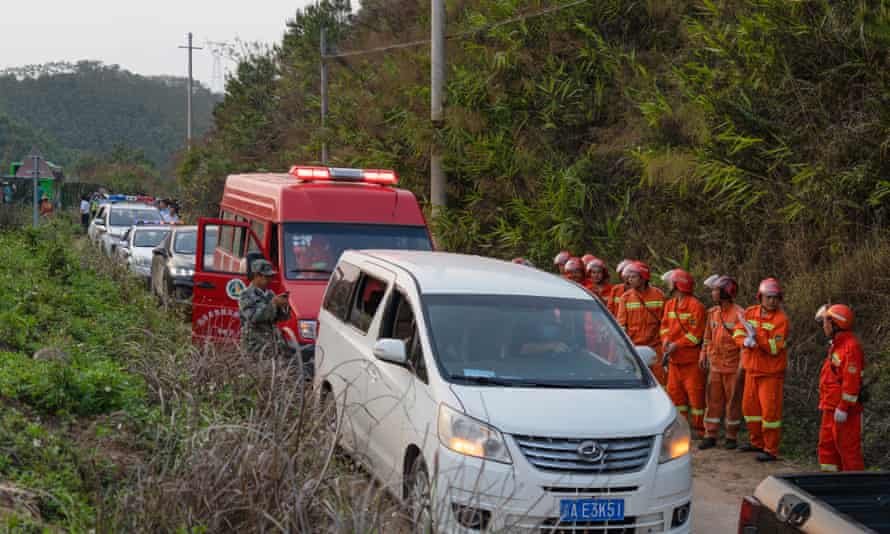
Chinese media outlet The Paper reported another man, referred to as Liu Li, was on his way to Guangzhou from Kunming for a reunion with his family after they bought him a ticket. Another report described a young woman on her way to meet her fiance.
“We couldn’t reach her,” her brother said. “She should have been arriving at Guangzhou after two hours. Her fiance is waiting for her at Guangzhou airport, he couldn’t find her or reach her.”
Initial reports said there were 133 people aboard, a number which was later corrected after it emerged a passenger had cancelled their flight prior to boarding.
Authorities have established a huge presence near the crash site, with multiple first responder groups, trauma specialists, psychologists, government emergency coordinators, and media. Live coverage by state media shows villagers on motorbikes carrying rescue workers and supplies up the mountain trail to the scene.
The crash is China’s worst air disaster in at least a decade, and follows recent government praise for the industry’s vastly improved safety track record. The plane flying route MU5735 was not a Boeing 737 Max, which was grounded after two fatal crashes in 2018 and 2019, but a Boeing 737-800, one of the world’s most common passenger planes. China Eastern Airlines has grounded all of that model in its fleet, as investigations continue.
“Our thoughts are with the passengers and crew of China Eastern Airlines Flight MU 5735,” Boeing said in a statement. “We are working with our airline customer and are ready to support them.”
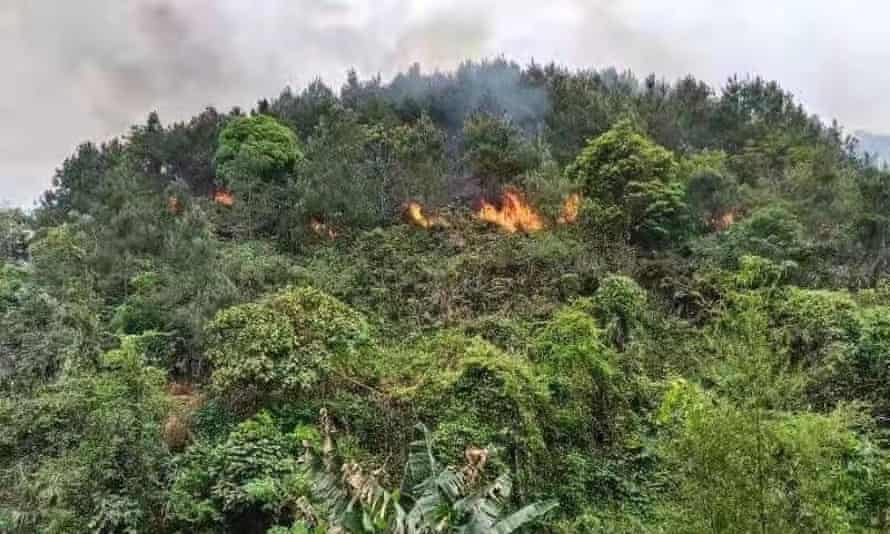
CCTV footage from a nearby mine, shared online and verified by Jimu News and the Wall Street Journal, purports to capture the plane’s horrifyingly steep final descent, plunging at just 35 degrees off vertical.
Aviation experts in the UK said there could be multiple reasons for the crash until further evidence emerged. Tony Cable, an air accident investigator, said possibilities included a “loss of control event” or high altitude stall. Crashes during the cruising period of a flight are rare.
China’s leader, Xi Jinping, called for an all-out response and investigation. Hu Xijin, a former editor of the Global Times, China’s nationalistic tabloid, called for the company to keep people updated, perhaps referring to the public furore and eventual arrests after officials covered up the true extent of the death toll in last year’s Henan flood disaster. “Absolutely do not wait until the formal end of an investigation before notifying the public,” he said.
The airline said there were no foreign nationals among the passengers. Authorities in Taiwan – which China claims as a province against its stated status as an independent nation – are working to determine if any of its citizens were onboard.
Additional reporting by Chi Hui Lin and Xiaoqian Zhu
Issued on: 22/03/2022
Text by: NEWS WIRES
Rescuers in China scoured heavily forested slopes on Tuesday with hopes fading of finding any survivors from the 132 people aboard a China Eastern Airlines passenger jet that crashed a day earlier in the mountains of southern Guangxi.
Parts of the Boeing 737-800 jet were strewn across mountain slopes charred by fire after China’s first crash involving a commercial jetliner since 2010. Burnt remains of identity cards, purses and wallets were also seen, state media reported.
Flight MU5735 was en route from the southwestern city of Kunming, capital of Yunnan province, to Guangzhou in Guangdong province bordering Hong Kong, when it suddenly plunged from cruising altitude at about the time when it would normally start to descend ahead of its landing.
Chinese media carried brief highway video footage from a vehicle’s dashcam apparently showing a jet diving to the ground behind trees at an angle of about 35 degrees off vertical. Reuters could not immediately verify the footage.
“The plane fell vertically from the sky,” state-run Beijing Youth Daily quoted a local resident as saying.
“Although I was far away, I could still see that it was a plane. The plane did not emit smoke during the fall. It fell into the mountains and started a fire.”
Lu, 64, a villager near the crash site who declined to provide his first name, told Reuters he heard a “bang, bang” at the time of the crash. “It was like thunder!” he said.
State media have described the situation as “grim”, and that the possibility of all onboard perishing could not be ruled out.
A working group from the Chinese aviation regulator was deployed to the crash site, alongside fire rescue and paramilitary forces.
Vice Premier Liu He left for Wuzhou city in Guangxi on Monday night to oversee the rescue efforts and crash investigation after an emergency government meeting.
State media described the crash site as being hemmed in by mountains on three sides, with access provided by just one tiny path. Rain was forecast for the area this week.
Authorities barred journalists and onlookers from approaching the site, keeping the road clear for emergency service vehicles.
Abrupt descent
U.S.-based aviation analyst Robert Mann of R.W. Mann & Company said investigators will need the flight data recorders to understand what might have caused the abrupt descent suggested by Automatic Dependent Surveillance-Broadcast (ADS-B) data. ADS-B is a technology that allows aircraft to be tracked.
The crash comes as Boeing seeks to rebound from several overlapping crises, including the coronavirus pandemic and crashes involving its 737 MAX model. The cockpit voice recorder could also yield clues to what went wrong once it is found.
“Accidents that start at cruise altitude are usually caused by weather, deliberate sabotage, or pilot error,” Dan Elwell, a former Federal Aviation Administration head, told Reuters.
Elwell, who led the FAA during the 737-MAX crisis, said mechanical failures in modern commercial jets were rare at cruise altitude.
China Eastern and two of its subsidiaries on Monday grounded its fleet of 737-800 planes, state media reported. The group has 225 of the aircraft, data from British aviation consultancy IBA shows.
Other Chinese airlines have yet to cancel any of their flights that use 737-800 aircraft as of Tuesday, according to data from Chinese aviation data provider Flight Master.
Onshore-listed shares of China Eastern slumped more than 6.5% on Tuesday, while those trading in Hong Kong fell nearly 6%.
Dinglong Culture, a Guangzhou-headquartered firm whose businesses range from entertainment to titanium mining, said on Tuesday its chief financial officer Fang Fang had been on the flight. The company said it was closely monitoring rescue developments and would arrange support for her family.
The last crash of a commercial jetliner in China was in 2010, when an Embraer E-190 regional jet flown by Henan Airlines crashed, killing 44 of 96 people on board.
(REUTERS)
DIVE BOMB
In an age where every flight is instantly tracked, data and images of a journey that ended with 132 people dead have kicked off an extraordinary global guessing game.
Clive Irving
Published Mar. 21, 2022
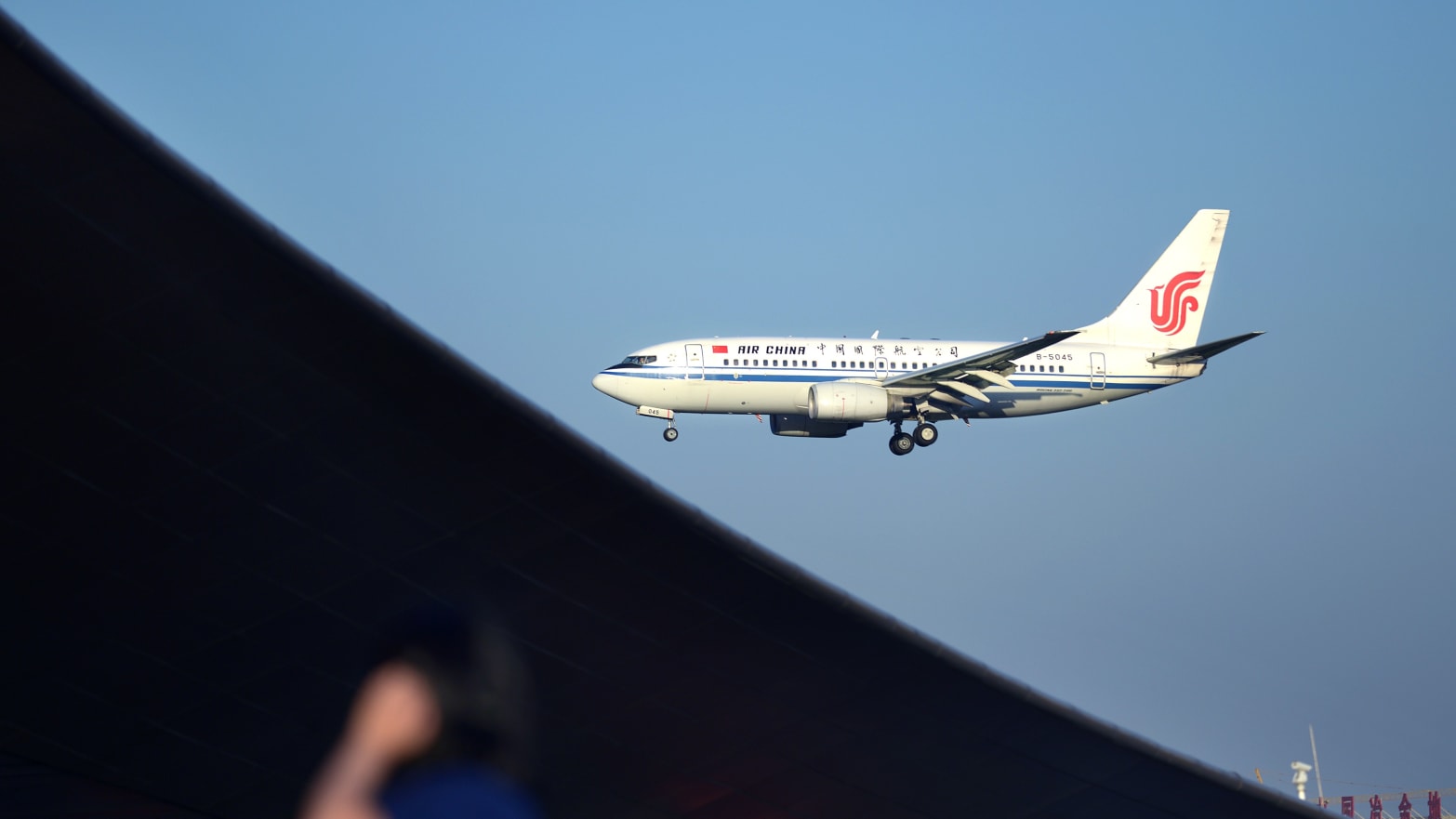
WANG ZHAO/AFP via Getty Images
Aviation experts are baffled by data showing that a China Eastern Boeing 737-800 about to begin its descent to the city of Guangzhou suddenly plunged vertically to earth like a missile, killing the 123 passengers and nine crew aboard on Monday.
This horrific disaster, the worst in recent Chinese aviation history, highlights that the kind of data that once took investigators at least days to gather is now instantly available from open source tracking sites like FlightRadar. As a result, speculation about the cause of a crash creates an instant Twitter storm as pilots and technical experts attempt to interpret what they are looking at.
Boeing 737 Was Plunging at 350MPH in Moments Before Crash
STRAIGHT DOWN
Philippe Naughton
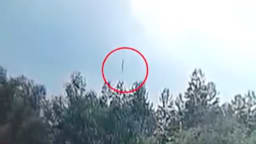
In this case, there is a striking consensus that something very unusual happened that cannot directly relate to previous disasters involving this version of the 737, one of the most flown jets in the world, which preceded the 737-MAX version that was grounded for nearly two years after two catastrophic accidents.
The flight pattern revealed by radar shows that the airplane was flying at 29,100 feet over mountainous terrain, with the crew about to prepare for the descent, when the nose abruptly pitched down and it began the dive. As it neared the terrain it seemed to briefly pull up but then resumed the dive to impact with enormous force.
The only certain details are what did not happen: there was no indication of an engine fire and no sign of any major part of the airplane breaking up. Significantly, there was no time for the crew to send a Mayday distress call.
There have been several cases of various models of the 737 suffering an explosive decompression, when part of the fuselage structure, weakened by undetected cracks in the outer skin, suddenly rips open and the air in the pressurized cabin is released in a blast, but even with that damage pilots have been able to get the airplane down safely, even with parts of the cabin open to the skies.
But those events happened early in the flights, when the airplanes were reaching cruise altitude, not as in this case at the end of the cruise and at the beginning of the approach to the airport.
One aerospace engineer, commenting on the Aviation Herald site, says, “It is not normal for a plane to nose dive into the ground, it rules out a lot of failures.” Another says, “To those who can’t think of any reason… there are a lot. Some repeats from things that already happened, perhaps something that has never happened before. Aviation is like that.”
The Machiavellian Reason China Is Squeezing Boeing
Clive Irving

There was a case where a similar dive was involved: in 1997 Silk Air Flight 185, when an earlier model 737 crashed into a river in Sumatra, killing 104 people, where an investigation by the U.S. National Transportation Safety Board concluded that the pilot had deliberately triggered the dive in an act of suicide, but this verdict was disputed by Indonesian regulators, who cited problems with the rudder controls that had caused other crashes of that model.
Another possibility is that although no break-up was visible on the radar track some part of the horizontal stabilizer, which would be activated to begin descent, may have broken off.
All of this leads to one urgent task—to find an answer in the one place where it should be found, in the airplane’s black boxes. The crash site is accessible and teams are headed there. There is, however, some concern that these flight data recorders might not survive such a devastating impact.
The Chinese regulators and investigators are highly regarded. China was the first country to ground the 737-Max and the last to allow it to return to the skies. Domestic air travel in China has grown rapidly in the last decade but there have been very few accidents.
Before the plane crash in China's Guangxi on Monday, the Boeing 737-800 model was involved in 22 accidents, according to Aviation Safety Network (ASN).
Ten among those incidents were fatal, per the ASN database, with the first fatal crash on the record happening in September 2006 when an 18-day-old 737-800 collided mid-air in Brazil, killing 154 people.
The most recent case happened in August 2020 when an Air India Express flight slid off the runway in Kozhikode-Calicut Airport in India, killing 21 people.
At about 2:38 p.m. on Monday, a China Eastern Airlines passenger jetliner with 132 people on board crashed into a mountainous area in southern China's Guangxi Zhuang Autonomous Region.
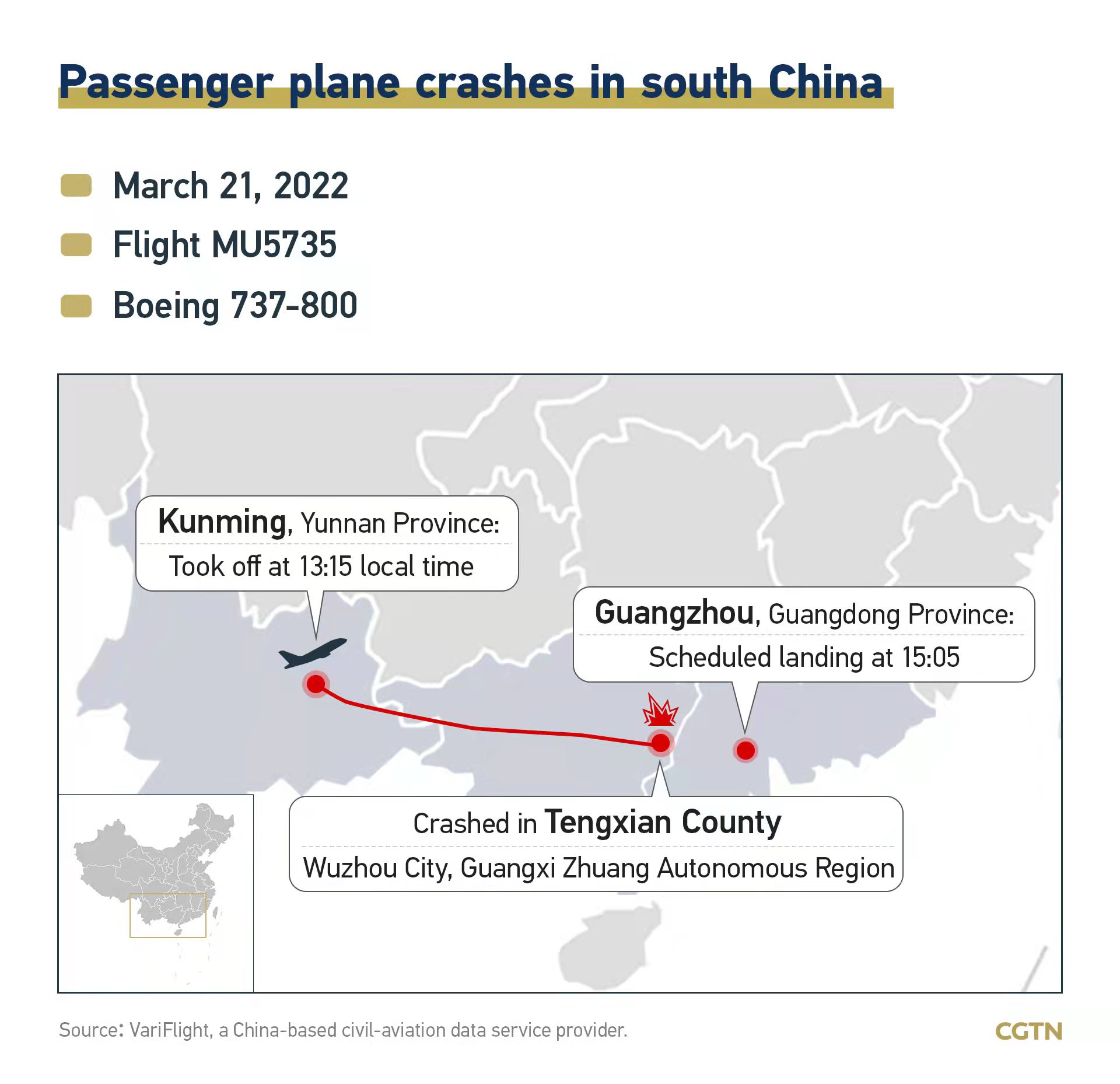
Graphic by CGTN's Liu Shaozhen
The plane was flying from the southwestern city of Kunming to south China's Guangzhou when it lost contact over the city of Wuzhou, the Civil Aviation Administration of China confirmed.
The number of casualties remains unknown as of 11:30 p.m. Beijing time. Company officials said the carrier has grounded all Boeing 737-800 aircraft after the crash.
Here is a list of all the accidents involving the model:
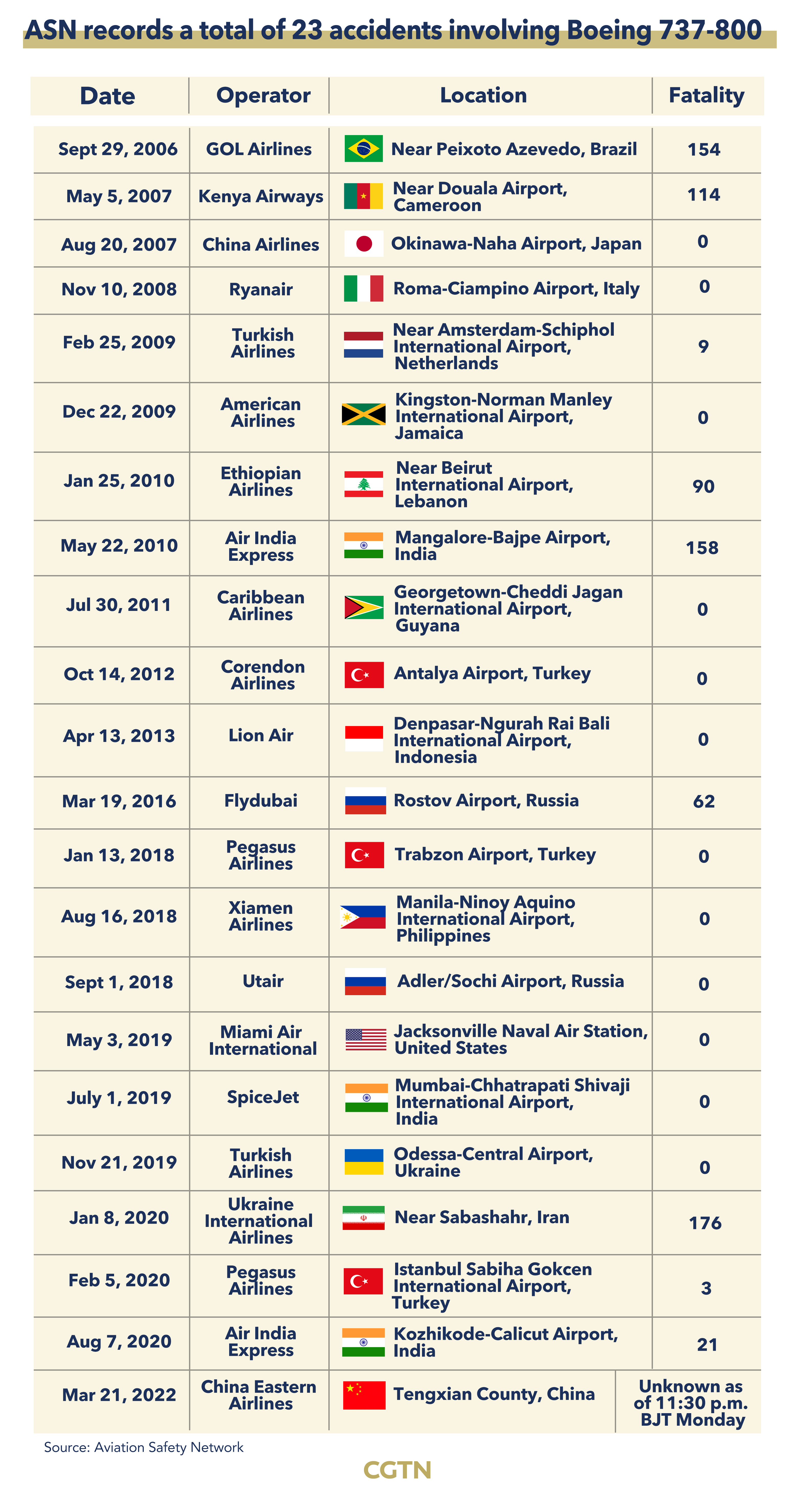
Graphic by CGTN's Zhu Shangfan
The Boeing 737-800 NG is widely used around the world.

By Niraj Chokshi
March 21, 2022,
The Boeing 737-800 NG, the model that crashed in China on Monday, is a workhorse of the skies.
There are nearly 25,000 passenger planes in service worldwide, according to Cirium, an aviation data provider. Of those, about 4,200, or 17 percent, are Boeing 737-800 NGs. China is home to nearly 1,200 of those planes, followed by Europe, with nearly 1,000, and the United States, with nearly 800.
American Airlines has 265 737-800 NGs in service, while Southwest Airlines has 205, United Airlines has 136 and Delta Air Lines has 77, according to Cirium. Boeing delivered nearly 5,000 of the planes to customers between 1998 and 2020, according to Boeing data.
China is the largest market for Boeing planes after the United States. Last year, Boeing forecast that the number of commercial planes in China would double by 2040, with Chinese airlines needing 8,700 new aircraft by then, valued at about $1.47 trillion.
The country is perhaps more crucial for Boeing’s leading rival, Airbus. Last year, Airbus delivered 142 commercial aircraft to China, its largest single-country market, representing a quarter of Airbus’s global commercial aircraft production.
Airbus has a mammoth assembly line in the city of Tianjin, producing the A320 single-aisle planes and A330 wide-body passenger jets. It also has relationships with Chinese airline and helicopter operators, and many components in Airbus jets are made by Chinese companies. The value of the Airbus and Chinese cooperation reached around $500 million in 2015.
Liz Alderman contributed reporting.
Niraj Chokshi covers the business of transportation, with a focus on autonomous vehicles, airlines and logistics. @nirajc
China Plane Crash
China sends emergency teams, top official to oversee first full day of rescue.
The China Eastern plane descended more than 20,000 feet in just over a minute.
A deafening boom, a plume of smoke: Farmers describe a plane plunging from the sky.
Shares of Boeing are lower after the China Eastern plane crash.
China’s recent air safety record is strong, after a troubled past.
China Eastern is the nation’s second-biggest carrier.
No comments:
Post a Comment